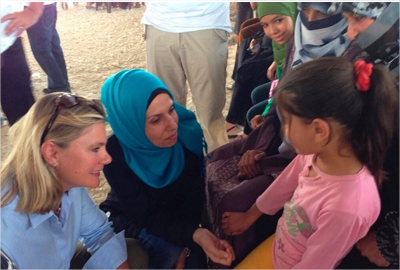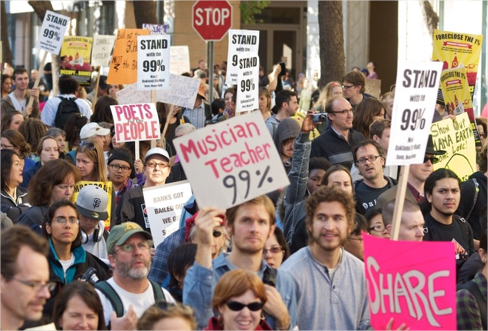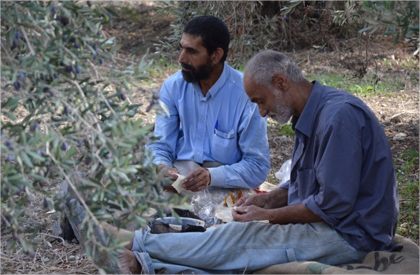1.1: Broadening our Horizons
- Page ID
- 51284
In efforts to explain the world’s population to young children, David J. Smith asks children to imagine the world as a small village so they can understand the vast population figures in a more comprehensible way. In 2012, the world’s population was 7,050,000,000 (Smith 7). Instead of talking about numbers of this magnitude, he represents the world as 100 people, where one imaginary person represents 70,500,000 people from the real world. Using Smith’s model, we can more easily examine what nationalities make up the world’s population, what languages they speak, how old they are, and how these statistics involve wealth and education.
Here are some interesting facts from Smith’s global village (8). Of the 100 people living in the village:
- 60 are from Asia
- 15 are from Africa
- 11 are from Europe
- 8 are from South and Central America (including Mexico) and the Caribbean
- 5 are from the United States and Canada
- 1 is from Oceania
So, how do these 100 people talk with one another? While there are nearly 6,000 languages spoken in this village, more than 50% of the villagers speak one of these eight (10):
- 27 speak a Chinese dialect (16 speak Mandarin)
- 9 speak Hindi
- 9 speak English
- 7 speak Spanish
- 4 speak Bengali
- 4 speak Arabic
- 3 speak Portuguese
- 3 speak Russian
Although there are 36 school-aged villagers (5-24 years), only 30 of them go to school, and there is only one teacher. Of the people old enough to read, 14 cannot read at all. Male villagers are taught to read more than females (Smith 21). While 68 villagers breathe clean air, the remaining 32 villagers breathe unhealthy air due to pollution (Smith 18). If each villager earned a similar annual income, each one would have $10,300 per year. Instead, the richest 10 people in the village earn more than $87,500 a year, the poorest 10 villagers earn less than $2 a day, while the remaining 80 earn somewhere in between. As the average annual cost of food and shelter in the village is more than $5,000, many people go without these basic necessities (Smith 22).
Moreover, it probably does not surprise you that the people with less money are also likely not to have electricity and education. Besides simple cultural differences such as what language one speaks or the foods they prefer; cultural identity impacts individuals’ accessibility to certain resources such as shelter, electricity, running water, health care, education, and political and legal systems.
If we return to the United States from our look at the global village we see that according to Moore (62-63, 149-50):
- About 20 percent of young black men ages 16-24 are neither in school nor working. Compare this to 9 percent of young white men.
- Black women are four times more likely than white women to die in childbirth.
- Black levels of unemployment have been roughly twice those of white since 1954.
- Women hold only 13 seats in Congress.
- 496 of the top 500 companies are run by men.
- Women’s earnings average 76 cents for every $1 earned by men—resulting in a lifetime loss of over $650,133.
- To make the same annual salary as her male counterpart, a woman would have to work the entire year PLUS an additional four months.
- The United States is one of the few countries in the world that puts to death both children and those with intellectual disabilities. The other five countries in the world that execute their children are Iran, Nigeria, Pakistan, Saudi Arabia, and Yemen.
Think about culture and communication as a reciprocal process: culture affects communication and communication affects culture. Both work together to shape how we identify as belonging to one culture or another, how we feel about belonging to a particular cultural group, how we communicate with other cultural groups, and how that group is regarded in the larger social system. In other words, what is the value and level of power afforded to various cultural groups? As you will see, this is often a reflection of the language used to refer to a particular group of people, or the relative value placed on their communication practices.
What is Intercultural Communication?
Intercultural communication refers to the process of interacting with people who are different from oneself in fundamental ways related to appearance, language, worldviews, or a number of other categories. For many people this phenomenon is part of their everyday lives, for example, in multilingual, multicultural communities or in culturally diverse families. The majority of human societies deal with multiple cultures and multiple languages. The USA has traditionally been one of the few countries in which it is possible to be successful even if one speaks only one language, English (Nieto, 2010). The USA, however, is shifting demographically in ways that are likely to change dramatically attitudes towards language and culture. By the year 2042, demographers tell us, non-Hispanic whites will be in the minority (Roberts, 2008).
The USA is by no means unique in undergoing this process. The means of communication and transportation available today result in more mixing of cultures than ever before. This coincides with trends in commerce and trade in recent decades which have facilitated growing internationalization in all areas of business and economic activity. This process of globalization is facilitated by social media activities of people around the world. Communicating with others who are physically remote is possible through social networks such as Facebook or through online conversations via Skype or chat programs such as WhatsApp. At the same time, political and economic forces are causing large numbers of people to become asylum-seekers or economic refugees, creating more diverse cities and countries throughout the world. This process can also create conflict, sometimes due to concerns of foreigners taking jobs away or changing the character of a region, and sometimes due to fear arising from willful ignorance and xenophobia – the fear of foreigners.
In fact, globalization is by no means, as often portrayed a benign process, benefiting humanity universally. While many in developed countries enjoy international travel, increasing prosperity, and safe communities, those in other parts of the world continue to experience severe deprivations (food, water, housing), mass unemployment, and violent communities. These conditions, along with unequal access to education and healthcare, are often accompanied by corruption and political powerlessness. This has led to mass migrations and social instability. Within developed countries, there are sharp divisions based on geography, social class, and income. These disparities, along with changes in the global economy, have propelled populist and nationalistic leaders in many parts of the world to power.
The Need for Intercultural Communication Today
Given the demographical and globalizing trends of recent decades, in today’s world one is likely to have more encounters (online or in person) with people from different cultures. Technological advances have played a major role in bringing people together. The Internet has reached the remotest corners of the world, as has satellite and online entertainment. People are able to see and appreciate differences in culture, way of life, and ways of interpreting the world at the click of a button. To add to this is the increasing ease of travel to different parts of the world for both work and pleasure (for the privileged). This has possibly resulted in a significant decrease in communication apprehension and a visible increase in the need and desire to be interculturally sensitive and competent. From that perspective, there is certainly a personal incentive for being interculturally sensitive. The openness and flexibility needed for successful cross-cultural exchanges offer benefits in personal and professional interactions of all kinds. Becoming knowledgeable about other cultures is also invaluable in gaining deeper insight into one's own culture. An experience living abroad or in close contact with those from another culture can lead to dramatically changed perspectives on the values and behavior patterns of one's native country.

There is in addition a practical, utilitarian benefit, as companies are increasingly looking for employees who are flexible, tolerant, and able to work with others different from themselves. In virtually every business today, what happens in other countries can have a serious impact on its operations and viability. Communities and societies benefit as well, as understanding and tolerance reduce animosity and conflict. This is of increasing importance today, as we see a rise in nationalistic movements in many countries, often accompanied by growing calls for political isolation, economic nationalism, and stricter immigration controls. In part, this is a response to the fact that the forces of globalization have resulted in disadvantages for particular local populations in terms of job opportunities and economic well-being. These tendencies have unfortunate byproducts, namely the rise of prejudicial attitudes towards members of minority groups and a closing-off of minds and feelings towards those who act or look different.
It is of particular importance for future leaders to gain insight and empathy into other cultures. National or regional officeholders, heads of political parties, and others in the public eye (entertainers, writers, activists) function as role models. Their views, opinions, and behaviors can have a substantial public influence. Figures like Pope Francis, Malala Yousafzai, or Greta Thunberg have exerted positive influence, respectively, on views of minority rights, educational opportunities for girls, and the need for immediate action on climate change. Unfortunately, we have seen in recent years public figures advocating for ideas and policies which divide and inflame communities, such as white supremacy or rejection of equal rights for LBGTQ individuals. Messages of this kind — of hatred and bigotry— can fall on receptive ears, particularly if an individual or a community has not often encountered individuals different in ethnic background, religious belief, or language:
Many societies are deeply divided: the anger of rural and deindustrialized communities cut adrift by neoliberal globalization is readily harnessed against the more concrete scapegoat of minorities, particularly if people have little experience with diversity. Against this context, opportunities for everyday mundane connections that allow people to engage beyond the stereotypes can become a crucial means to overcoming division and exclusion (Piller, 2017, p. 203).
Studies have shown that the geographical regions with the lowest number of immigrants or members of a minority tend to have the highest level of negative views of those groups. This is a clear indication that these views are not based on experience or evidence but on uninformed opinions based on slanted media or anecdotal information from friends or family. Piller (2017) provides a hopeful example, namely Sudanese immigrants in a virtually all-white Australian community becoming socially accepted by individuals and community leaders who reach out beyond stereotypes and their in-group bubbles.
Intercultural understanding is essential as well in gaining an informed and balanced appreciation of media, whether that be television reports focusing on other countries or blog posts from abroad. Today there is a vast amount of information freely available, through media channels and the Internet. Understanding the perspective from which others view the world can be very helpful in becoming informed consumers of news stories and social media. Given the importance of this topic, it will form a thread through many of the discussions in this textbook.
One of the reasons identities are complex today is the pervasive influence of modern media, which crosses cultural and linguistic boundaries. Participation in social media can be such a central aspect of one's life as to have a determining effect on worldview, values, and behaviors. Individuals can become members of online communities which acquire over time more importance than national characteristics, religious affiliations, or even families. Such relationships may be virtual, but they are just as real – and can be just as strong – as in-person relationships.
Ethics and intercultural communication
When we reference the widespread use of social media, we need to keep in mind the very real nature of the digital divide between those (predominately in developed countries) with easy access to Facebook and other online services and those (predominately in developing countries) who have no Internet connectivity, and possibly even no access to electricity. In fact, for many of our co-denizens of the 21st-century, daily routines do not involve reading tweets, posting Facebook updates, or checking Instagram, but rather seeking to fill basic human needs — food, water, shelter. About 50% of the world’s population lives below the internationally recognized poverty line, living on less than $2.50 a day. The forces of globalization, discussed at the beginning of this chapter, have indeed brought the world closer together in terms of communication and commerce, but large numbers of people have been left out. That includes not only individuals from countries in Africa, Latin America or Southeast Asia, but also factory workers and others holding blue-collar jobs who have lost their livelihoods to outsourcing or to companies moving factories to lower wage economies. There has been in recent years a growing recognition of the inequality in the distribution of wealth, leading to phenomena such as the “Occupy” movement of 2011-2012, protesting against the elite 1% of the population, or the election of Donald Trump in the United States in 2016, who was elected in large part due to votes from those who feel left out of the 21st-century US economy.
The Digital Divide
Many people who are now college age struggle to imagine a time without cell phones and the Internet. As “digital natives” it is probably also surprising to realize the number of people who do not have access to certain technologies. The digital divide was a term that initially referred to gaps in access to computers. The term expanded to include access to the Internet since it exploded onto the technology scene and is now connected to virtually all computing (van Deursen & van Dijk, 2010). Approximately two billion people around the world now access the Internet regularly, and those who don’t face several disadvantages (Smith, 2011). Discussions of the digital divide are now turning more specifically to high-speed Internet access, and the discussion is moving beyond the physical access divide to include the skills divide, the economic opportunity divide, and the democratic divide. This divide doesn’t just exist in developing countries; it has become an increasing concern in the United States. This is relevant to cultural identities because there are already inequalities in terms of access to technology based on age, race, and class (Sylvester & McGlynn, 2010). Scholars argue that these continued gaps will only serve to exacerbate existing cultural and social inequalities. From an international perspective, the United States is falling behind other countries in terms of access to high-speed Internet. South Korea, Japan, Sweden, and Germany now all have faster average connection speeds than the United States (Smith, 2011). And Finland in 2010 became the first country in the world to declare that all its citizens have a legal right to broadband Internet access (ben-Aaron, 2010). People in rural areas in the United States are especially disconnected from broadband service, with about 11 million rural Americans unable to get the service at home. As so much of our daily lives go online, it puts those who aren’t connected at a disadvantage. From paying bills online, to interacting with government services, to applying for jobs, to taking online college classes, to researching and participating in political and social causes, the Internet connects to education, money, and politics.
- What do you think of Finland’s inclusion of broadband access as a legal right? Is this something that should be done in other countries? Why or why not?
- How does the digital divide affect the notion of the global village?
- How might limited access to technology negatively affect various nondominant groups?
To be truly interculturally competent means not only being responsible and empathetic in our personal encounters, but extending that process more broadly. We need engaged global citizens, knowledgeable and caring about people and events outside our own backyards. Part of that process is being cognizant of the privileged position many of us enjoy. Important in that process is a willingness to break out of our regular routines of communication and information retrieval, occasionally stepping outside our social media bubble to encounter different voices and points of view. In that way, we are likely to be better informed about the complexities and fragmentations of global communities. This can lead to an enhanced recognition of the need for social justice, i.e. the struggle to confront discrimination and challenge inequities. We are both consumers and producers of culture and we all have a role in shaping the nature of the world in which we live. From that perspective, it is important not to think of culture as a fixed entity with a controlling influence on our lives. Cultures, as are all human affairs, are not immutable, but rather subject to change through a variety of forces.

There is a natural human tendency to want to be among those similar to ourselves, known as homophily. It takes some effort to overcome this normal human instinct. Part of that phenomenon makes us leery of those who look different, belong to different ethnic groups, or profess other worldviews. Those who seem different become the "other", rejected for being dissimilar and therefore considered inferior (see Scollon, Scollon & Jones, 2011). This rejection of others who have different ethnic backgrounds or practice other religions has in human history led to multiple instances of civil strife and war, including in recent times conflicts in many parts of the world from Northern Ireland to South Sudan. In extreme cases, the result can be ethnic cleansing and genocide, as we have experienced in the 20th century in Armenia, Germany, and Rwanda. That process of othering is intensified if we feel threatened in our livelihood or security by new arrivals. This has been one of the unfortunate byproducts of the large wave of refugees beginning in 2015, principally to Europe, from Syria, Iraq, Afghanistan, and north Africa.

As the number of immigrants has increased in countries like Great Britain, France, Germany, some feel that not only are jobs and security at risk, but also the very existence of their cultures. This has led to the rise of a number of new movements and political parties in Europe which promote xenophobia and economic nationalism. The vote in Great Britain in 2016 to leave the European Union was not just an assertion of national independence, but also a rejection of the influx of foreigners. We have witnessed similar shifts towards greater nationalism in a variety of countries including Turkey, Russia, India, and the United States. Unfortunately, the patriotism evident in these developments often translates into a kind of free license to discriminate against minorities, whether that be Muslims in India or Latinx in the US. Political leaders play a crucial role here in setting the tone, thereby influencing followers in terms not only of attitudes but also of behavior. This is one of the strongest reasons we need today worldwide more intercultural understanding, so that future leaders are acculturated to accept diversity and practice tolerance.
Contributors and Attributions
Language and Culture in Context: A Primer on Intercultural Communication, by Robert Godwin-Jones. Provided by LibreTexts. License: CC-BY-NC
Intercultural Communication for the Community College, by Karen Krumrey-Fulks. Provided by LibreTexts. License: CC-BY-NC-SA


